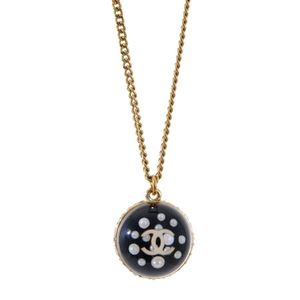Pietra Dura Pendant on Gold Chain
A pietra dura pendant, with inlaid floral and foliate design, 45 x 35 mm, suspended from a gold serpentine chain, total length 700 mm
You must be a subscriber, and be logged in to view price and dealer details.
Subscribe Now to view actual auction price for this item
When you subscribe, you have the option of setting the currency in which to display prices to $Au, $US, $NZ or Stg.
This item has been sold, and the description, image and price are for reference purposes only.
- Foliate - Decorated with leaves or leaf-like forms.
- Pietra Dura / Florentine Mosaic - Pietre dura, also known in English as "Florentine mosaic" is a decorative art that originated in Renaissance Italy and involves the creation of intricate, multi-layered inlaid designs using a variety of different coloured stones. The name "pietre dura" is Italian for "hard stones," and refers to the use of hard, durable materials such as marble, agate, jasper, and other semiprecious stones in the creation of the designs.
The origin of pietre dura can be traced back to ancient Rome, where the technique was used to create intricate inlaid designs for mosaic floors, walls, and other architectural elements. During the Renaissance, the technique was revitalized in Italy and became particularly associated with the city of Florence. The court of the Grand Duke of Tuscany, Cosimo I de' Medici, was a major patron of pietre dura and employed many of the leading artists and craftsmen of the time to create a wide range of objects, from small items like jewelry boxes and vases to large panels and furniture.
In the 19th century, pietre dura was used to create a wide range of decorative objects, from furniture and decorative panels to small items like jewelry boxes, vases, and picture frames. During this time, the technique was particularly popular in Europe, where it was used to create elaborate pieces of furniture and other decorative objects for the wealthy and aristocratic classes.
In addition to traditional pietre dura objects like cabinets, tables, and vases, the 19th century saw the development of new forms of pietre dura, such as book covers, cigar boxes, and other small items. This was largely due to the advent of new, more affordable production techniques and materials, which allowed for the creation of pietre dura objects on a larger scale and at a lower cost.
This item has been included into following indexes:
Visually similar items

A solitaire diamond pendant, the early round brilliant cut diamond of 5.75cts collet set and suspended from a snake chain, all in 18ct gold, total length 445 mm
Sold by
in
for
You can display prices in $Au, $US, $NZ or Stg.

1910 Melbourne gold sovereign. With 18ct mount & chain, length 22 cm (chain) Wt. 14.5g
Sold by
in
for
You can display prices in $Au, $US, $NZ or Stg.

An enamel cupid stick pin, in 15ct gold, total length 90 mm, fitted box
Sold by
in
for
You can display prices in $Au, $US, $NZ or Stg.

A necklace by Chanel, styled as 'CC' motif gemset resin pendant to a gold metal chain
Sold by
in
for
You can display prices in $Au, $US, $NZ or Stg.
